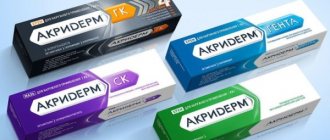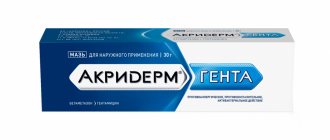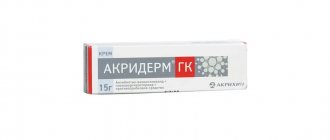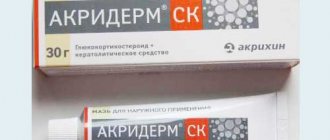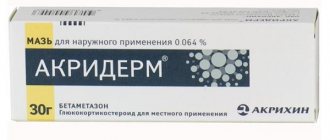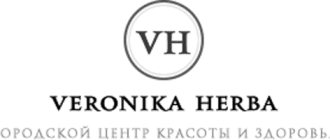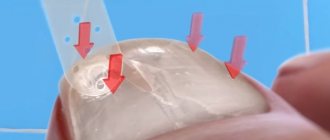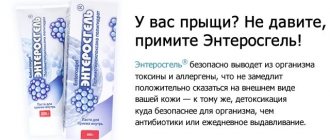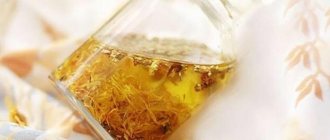The hormonal drug Akriderm for lichen has found widespread use. It belongs to the group of glucocorticosteroid drugs used to treat inflammatory processes of the skin and allergic reactions. The antifungal property allows Akriderm to be used in the treatment of lichen in children and adults. It is recommended to use the medicine after consulting a doctor, since the dosage and duration of the therapeutic course, as well as the safety and effectiveness of treatment, depend on many factors.
Akriderm - what is this ointment for?
The medication is often used to treat dermatological diseases. It is allowed to be prescribed for:
- simple and allergic dermatitis (especially often in demand after the addition of secondary bacterial or fungal flora);
- widespread and local neurodermatitis (this also includes atopic dermatitis, simple chronic lichen);
- eczematous rashes;
- fungal infections of the skin and nail plates (dermatophytosis, candidiasis, pityriasis rosea).
It is not advisable to use it for a long time without consulting a doctor.
The Akriderm group of medications are recommended for the treatment of dermatomycosis and any skin diseases, including those complicated by secondary bacterial or fungal flora. The medications are well tolerated and effective. They help with both acute and chronic pathologies of the skin. This is confirmed by the scientific work of E.V. Matushevskaya, I.G. Shakurova, Z. R. Khismatulina “Efficacy and tolerability of drugs from the Akriderm line in the practice of a dermatovenerologist.”
Is Akriderm GK suitable for pregnant women and children?
No studies have been conducted to prove the absolute safety of the drug for pregnant and lactating women. Use ointment or cream with caution; apply only to small areas of the skin for a short period of time. Use is not recommended in the first trimester. If there is an urgent need to use ointment or cream during lactation, breastfeeding should be stopped for the period of treatment.
For children under two years of age, the drug in the form of an ointment is contraindicated according to the instructions. With long-term treatment, use on large skin surfaces and application of dressings, the glucocorticosteroid can penetrate into the systemic circulation.
In children from two to eighteen years of age, use with caution.
On the recommendation of a pediatrician or dermatologist, the cream can be used in the treatment of skin diseases in children over 1 year of age. But only for a short course and on small areas of the skin, since the epidermis in babies is not sufficiently developed and the risk of side effects increases.
Forms, composition
The medication is available in 2 forms: ointment and cream. The creamy texture is lighter and is distributed evenly over the skin. The ointment has a thicker texture, allowing the active substance to remain on the skin longer.
Forms that differ in composition (line of external products):
- Akriderm ointment and cream 0.05% 15 g, 30 g - contains betamethasone;
- Akriderm SK ointment 30 g, 15 g - contains betamethasone and salicylic acid;
- Akriderm GK ointment and cream is a combined hormonal ointment containing betamethasone, gentamicin, clotrimazole;
- Akriderm Genta ointment and cream 15 g, 30 g - contain betamethasone, gentamicin.
Depending on the pathology, one form or another is chosen.
Betamethasone is a glucocorticosteroid. It relieves inflammation, relieves allergic reactions by reducing swelling and itching.
Gentamicin is an antibacterial component. Kills bacteria. Not active against fungal and viral agents.
Clotrimazole is an antifungal component. It is active against candida fungus, dermatophytes, yeast and other microorganisms.
Salicylic acid has an irritating effect and relieves inflammation. It also promotes the exfoliation of the stratum corneum of the epithelium.
Material and methods
We observed 72 patients from 18 to 60 years old with steroid-sensitive dermatoses, of which 15 patients had chronic eczema of the hands, complicated by secondary infection; with microbial eczema - 14; with atopic dermatitis complicated by secondary infection - 15; with allergic contact dermatitis complicated by secondary infection - 28 patients. Patients applied to the diagnostic and treatment center of the clinics of the Siberian State Medical University for an outpatient appointment.
The treatment regimen was as follows: Akriderm GK
Apply a thin layer to the affected areas of sensitive skin 2 times a day.
The duration of treatment ranged from 7 to 14 days. Akriderm GK
ointment was applied in a thin layer to the affected areas of the body with pronounced peeling 2 times a day. The duration of treatment ranged from 7 to 14 days. The average duration of observation per patient was 1 month, during which there were three visits.
The selection of patients was carried out in accordance with the inclusion and exclusion criteria. The study included patients meeting the following criteria: men and women aged 18 to 60 years with steroid-sensitive dermatoses complicated by secondary infection. The study did not include patients with at least one of the following criteria: pregnancy less than 12 weeks; hypersensitivity to the drug or its components; the use of systemic and external corticosteroids, antibiotics, antifungal drugs. The study did not include patients with diseases and conditions indicated as contraindications to the use of the drug: skin tuberculosis, viral infections, perioral dermatitis, rosacea, vaccination.
Clinical effectiveness was assessed based on the reduction in activity and extent of the process. The study used a score for the symptoms of the disease: 0 points - no signs; 1 point - mild severity; 2 points - moderate severity and 3 points - strong severity.
The effectiveness of treatment was assessed according to the following criteria: clinical cure, significant improvement, improvement, no effect.
The timing of treatment results was noted on the 1st, 14th and 30th day from the start of therapy.
Before and during treatment of patients, the quality of life of patients was studied using a questionnaire. The transformation of the quality of life involved the respondent’s self-assessment of his physical, mental, social and economic well-being using a questionnaire using the dermatological quality of life index (DQL). The questionnaire made it possible to express in points the patient’s assessment of his physical condition, mood and general quality of life during the 1 week preceding the questionnaire, as well as to establish the reason for the decrease in quality of life and present the results in the form of a single number. The maximum score could be 30 points.
To analyze safety and tolerability indicators, we took into account adverse events (their characteristics and frequency), assessed on a 4-point categorical scale: excellent - no side effects; good - mild side effects that do not require medical intervention; satisfactory - moderate side effects; bad - severe side effects requiring discontinuation of the drug.
Comorbidity was not a criterion for excluding a patient from the sample population, and treatment of concomitant diseases was carried out according to the usual regimen, and the drugs used in their treatment could be used simultaneously with the drug Akriderm GK
(betamethasone + gentamicin + clotrimazole).
Statistical processing of the results was carried out using the SPSS 17.0 for Windows application package. The critical level of significance when testing statistical hypotheses in this study was taken to be p
=0.05 (achieved significance level). The distribution of quantitative data was checked using the Shapiro-Wilk test. The results of the study were summarized using the χ2 criterion.
Contraindications
Each form of medication has its own contraindications.
Restrictions on use for all types of medication:
- intolerance to the main and auxiliary components;
- syphilitic damage to the dermis;
- viral skin damage (herpes, chickenpox);
- vaccination and its skin manifestations;
- gaping wounds;
- children under 2 years of age;
- tuberculous damage to the dermis.
The list is supplemented
| Akriderm genta | Akriderm |
|
|
Undesirable manifestations
When using an external remedy, undesirable manifestations are possible, but they are mild.
Undesirable manifestations in all forms:
- local reactions: itching, burning, dry skin, folliculitis, hypertrichosis, steroid acne, allergic skin manifestations;
- when applying bandages: stretch marks, prickly heat, attachment of secondary flora, weeping;
- systemic manifestations: increased blood pressure, leaching of calcium from bones, weight gain, edema, ulcerative defects of the digestive tract mucosa, exacerbation of focal infections, menstrual irregularities, poor sleep, agitation.
The list is supplemented by the following undesirable manifestations of individual forms:
| Akriderm | Akriderm genta |
|
|
special instructions
All forms have the same precautions and instructions. Features of use:
- prevent contact of the medication with the mucous membrane of the eyes;
- if secondary flora is attached, you should stop using the external agent;
- The body surface area of a child is smaller than that of an adult patient, so the dose and duration of course therapy should be observed to avoid systemic manifestations.
Features of other forms
| Akriderm | Akriderm genta |
|
|
Akriderm SK
Results and discussion
As a result of an open observational study, data were obtained on the high effectiveness of Akriderm GK
(betamethasone + gentamicin + clotrimazole) in the treatment of steroid-sensitive dermatoses complicated by bacterial and/or fungal infection.
The use of the drug Akriderm GK
(betamethasone + gentamicin + clotrimazole) was assessed at the end of the observation.
An excellent assessment of the effectiveness of the drug was established in 70 (97.2%) patients, good in 2 (2.8%), satisfactory and unsatisfactory were not recorded in any case. Clinical cure was established in 97.2% of patients, significant improvement in 2.8%. Not a single patient remained without effect from the therapy. Excellent tolerability of the drug was noted in 98.6% of patients, good - in 1.4% (mild itching was noted, which went away on its own after 3 days). There were no significant side effects requiring discontinuation of the drug in our study. When using Akriderm GK
(beta-methasone + gentamicin + clotrimazole), the DIQL of patients statistically significantly improved.
We present clinical cases.
The patient is 13 years old, diagnosed with atopic dermatitis, complicated by bacterial and fungal infection (Fig. 1, a). When contacted, the patient complained of weeping in the axillary folds and itchy skin. Local status: against the background of brightly colored inflammatory erythema, yellow crusts, infiltration, and weeping are visible. Budding (yeast) cells were found in the scraping. Based on the clinical picture (layering of yellow crusts), we can talk about the addition of a bacterial (streptococcal) infection. The patient received the following treatment: fucorcin 1-2 times a day for 5-7 days, 10-15 minutes after drying, apply Akriderm GK
2 times a day for 7 days. During treatment, a decrease in the brightness of manifestations and inflammatory phenomena was noted. After treatment, the pathological process was completely resolved (fucorcin residues are visible) (see Fig. 1, b). Since the patient is a teenager, bristly hair growth is visible in the axillary areas. After 14 days and 1 month from the start of treatment, the patient was examined. The pathological process was in remission.
Rice.
1. Atopic dermatitis, complicated by bacterial and fungal infection, in a 13-year-old patient. a - before treatment; b - after treatment. The patient is 23 years old, diagnosed with microbial (coin-shaped) eczema: abortive form (eczematid) (Fig. 2, a). Differential diagnosis was made with mycosis of smooth skin. The pathological foci were erythematous-squamous, large in size, round, with clear boundaries, in the center there were areas of resolution with peeling. No threads of septate mycelium were found in the scraping. The following treatment was prescribed: Akriderm GK
2 times a day for 14 days. During treatment, the pathological lesions resolved completely (see Fig. 2, b), only light temporary pigmentation remained visible. The patient did not show up for further examination.
Rice.
2. Foci of numular eczema. a - before treatment, b - their regression after 14 days of therapy. The patient is 63 years old, diagnosed with atopic dermatitis, complicated by a fungal infection (Fig. 3, a, 4, a). The patient suffered from atopic dermatitis as a child. I did not notice any exacerbations with age. Complained of dry skin. On examination, dry skin and pronounced skin patterns in the elbow and popliteal folds were noted. When contacted, he complained of dry skin in the area of the palms, rashes in the area of the inguinal folds, accompanied by itching. In the area of the palms, powdery small folds and cracks were revealed; in the area of the inguinal folds there is a spot of hyperemia with clear sharp boundaries in the form of a roller consisting of crusts, scales, and erosions. Threads of septate mycelium were found in scrapings from the palms and inguinal folds. The following treatment was prescribed: Akriderm GK
2 times a day for 14 days on the groin area,
Akriderm GK
2 times a day for 14 days on the palms. After 14 days, the pathological process in the area of the palms and inguinal folds was completely resolved (see Fig. 3, b, 4, b). No threads of septate mycelium were found in scrapings from the palms and inguinal folds. The patient was examined 1 month after the start of therapy. The pathological process was in remission.
Rice. 3. Rashes due to atopic dermatitis on the hands of a 63-year-old patient. Fungal contamination has been proven. a — before treatment, b — after treatment.
Rice.
Fig. 4. Erythematous-squamous lesions in the area of the inguinal-femoral fold (a) and their regression in the same patient after therapy (b). The patient is 25 years old, diagnosed with allergic contact dermatitis, complicated by a bacterial infection (Fig. 5, a). On the skin around the mouth, against the background of bright hyperemia, yellow crusts and weeping are visible. The patient was prescribed the following treatment: sodium thiosulfate 30%, 10 ml intravenously for 10 days; Levocyterizine 10 mg orally 1 time per day (10 days); topical cream Akriderm GK
2 times a day (7 days). After 7 days, the pathological process was completely resolved: the rash around the mouth disappeared (see Fig. 5, b). The prescription of combination drugs containing topical corticosteroids and antibiotics for bacterial infections quite often provokes the growth of saprophytic candidiasis microflora, which worsens the course of the underlying disease. Therefore, the most effective combination therapy is drugs that contain corticosteroids, antibacterial and antimycotic agents, which makes it possible to simultaneously influence all parts of the pathological process [13].
Rice.
5. Manifestations of allergic contact dermatitis with impetiginization in a 25-year-old patient. a - before treatment; b - after treatment. Patient, 46 years old, diagnosed with chronic eczema of the hands, complicated by a secondary infection (fungal). The patient has been suffering from chronic eczema of the hands since the age of 20. It is also known from the medical history that the patient works as a driver. Hands often come into contact with lubricants. Periodically over the course of 26 years, exacerbations occur, which are replaced by remissions. The latest exacerbation is associated with nervous shock. At the time of treatment, the pathological process is represented by foci of mild hyperemia, there are yellow crusts, scales, scratches, small pink papular elements, cracks (Fig. 6, a, b). Noteworthy is the absence of supracungual skin (a sign of a candidiasis infection). Yeast-like cells were found in scrapings from the periungual ridges. The following treatment was prescribed: Akriderm GK
2 times a day for 14 days.
When examined after 14 days, the pathological process resolved: hyperemia disappeared, dry skin, peeling, and isolated crusts remained. Akriderm
ointment was prescribed 2 times a day (10 days). When examined after 10 days, the pathological process resolved completely (see Fig. 6, c, d). After 1 month from the start of therapy, the patient was examined. The pathological process was in remission.
Rice.
6. Chronic eczema of the hands, complicated by mycotic infection in a 46-year-old patient. a, b — skin status before treatment; c — after two weeks of external treatment with a three-component drug; d - after additional use of phonophoresis with the ointment used. The average for the group at the time of the first visit was 14 points (8; 18); 14 days after the start of therapy - 1 point (1; 5) ( p
<0.05);
1 month after the start of therapy - 1 point (1; 3) ( p
<0.05). At the time of the first visit, the high DIQL is explained by the fact that any manifestations of dermatoses lead to psycho-emotional problems in the patient. Moreover, even minor rashes are accompanied by high DIQL values, since they are located on an open area of the skin and are visible to others.
Analogs
Each form has its own analogue. List of structural substitutes by form (similar in composition):
| Form | Structural substitute |
| Akriderm SK | Rederm |
| Akriderm | Betamethasone-Vertex |
| Akriderm genta | Celestoderm |
| Akriderm GK | Triderm |
Non-structural substitutes contain another active ingredient. These include:
- Hydrocortisone ointment 1% - contains hydrocortisone, less effective, helps with allergic skin diseases without complications.
- Triacort - contains triamcinolone acetonide, helps with eczematous and psoriatic rashes, atopy and other skin pathologies (available strictly according to prescription!).
The choice of a substitute should be made by a doctor.
Akriderm is a popular line of external products in the field of dermatology. It is used for the treatment of skin diseases of various nature, such as complicated dermatitis (caused by allergies), eczema, neurodermatitis, and fungal damage to the skin. For each pathology, a different form of medication is selected that most effectively eliminates the symptoms of the disease. With proper use of drugs, the risk of unwanted effects is minimal.
Analogues of the drug
For patients who have not been helped by the described anti-lichen medication or for other reasons are unable to use it, doctors prescribe similar medications that are similar in their active substance and mechanism of action on the human body. Hormonal medication can be replaced by:
“Celestoderm” is one of the analogues of this group.
"Beloderm";- "Kuterid";
- "Betamethasone";
- "Celeston";
- "Diprospan";
- "Flosteron";
- "Celestoderm";
- "Betnovate";
- "Celeston."
